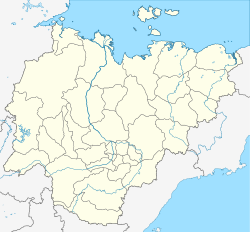Verkhnekolymsky ulus
Ulus / Rajon
|
||||||||||||||||||||||||||||||||||||||||||
The Werchnekolymski ulus ( Russian Верхнеколымский улус even район Верхнеколымский , Werchnekolymski rayon; Yakut Үөһээ Халыма улууһа , Üöhee Chalyma uluuha ) is one of 34 Ulusse ( Rajons ) of the Republic of Sakha (Yakutia) in the north of the Russian Federal District Far East . It is located in the north-east of the republic inland, south of Srednekolymski ulus . To the east it borders on Magadan Oblast . Like the Ulus, the village of Verkhnekolymsk , a little west of the administrative center Syrjanka , is called after its location on the upper Kolyma (Russian Verkhnyaya Kolyma ) compared to the Ulussen downstream .
geography
The Ulus has an area of about 67,800 km², little smaller than Bavaria , and is crossed by the Arctic Circle . It is located in the East Siberian mountainous region and covers part of the upper central reaches of the Kolyma, the headwaters of which are located in the Sussumanski rajon of the Magadan Oblast, which is connected upstream . In the east the Ulus forms part of the Jukagiren plateau , in the southeast the ridge of the Kolyma Mountains forms the continental divide between the Arctic and Pacific Ocean . Most of the vegetation consists of taiga and tundra .
Demographics
The population had more than tripled from 1939 to 1989, but has more than halved since then:
| year | Residents |
|---|---|
| 1939 | 3,241 |
| 1959 | 5,418 |
| 1970 | 6,627 |
| 1989 | 10.147 |
| 2002 | 5,653 |
| 2010 | 4,723 |
The population consists of members of indigenous ethnic groups , with a slightly increasing tendency . The share of the Jukagirs is the second highest among all ulusses in the republic.
| Ethnicity | 2002 | 2010 | ||
|---|---|---|---|---|
| people | % | people | % | |
| Yakuts | 1463 | 25.88 | 1350 | 28.85 |
| Jukagiren | 304 | 5.38 | 304 | 6.50 |
| Ewenen | 269 | 4.78 | 289 | 6.18 |
| Russians | 2999 | 53.05 | 2345 | 50.12 |
| Ukrainians | 318 | 5.63 | 177 | 3.78 |
Communities
The Ulus consists of 6 community formations, called nasleg in the Sakha Republic , there are the main towns Syrjanka (transkr.) / Zyrjanka (transli.) And five village places.
In the following list, the names are first in transliteration, then in Cyrillic script:
| No. | Surname | Population 2007 (2010) |
Note or center |
| 1) | Syrjanka - Зырянка ( jak. As russ. ) | 3,400 (3,384) | Urban-type settlement , administrative seat of the Ulus |
| 2) | Aryylaach - Арыылаах | 562 | Sybaataj - Сыбаатай |
| 3) | Ugol'naj - Угольнай | 535 | Sylgy Yytar - Сылгы Ыытар |
| 4) | Üöhee Chalyma - Үөһээ Халыма Russian Verchnekolymsk - Верхнеколымск |
364 | Üöhee Chalyma - Үөһээ Халыма, Russian Verchnekolymsk - Верхнеколымск |
| 5) | Nelemnej - Нелемнэй | 280 | Nelemnej - Нелемнэй |
| 6) | Utajy - Утайа | 102 | Utajy - Утайа |
The numbers indicate the ranking of the settlements according to the number of inhabitants and the identification in the map of the Verkhnekolymsk ulus, which is only available in the Yakut Wikipedia ("In other languages: Caxa") .
literature
- Pyotr Slepzow: Verkhnekolymski ulus: istorija, kultura, folklor . Bitschik, 2002, ISBN 978-5-7696-1334-0 .
Web links
- Verkhnekolymski ulus in the official information portal of the Republic of Sakha (Yakutia), in Russian
- Verkhnyaya Kolyma: ot istorii do naschich dnei (Russian)
Individual evidence
- ↑ Itogi Vserossijskoj perepisi naselenija 2010 goda. Tom 1. Čislennostʹ i razmeščenie naselenija (Results of the All-Russian Census 2010. Volume 1. Number and distribution of the population). Tables 5 , pp. 12-209; 11 , pp. 312–979 (download from the website of the Federal Service for State Statistics of the Russian Federation)
- ^ Results of the 2010 census for the Republic of Sakha (Yakutia) on the Sachastat (Yakutiyastat) website , Volume 4, Table 2



